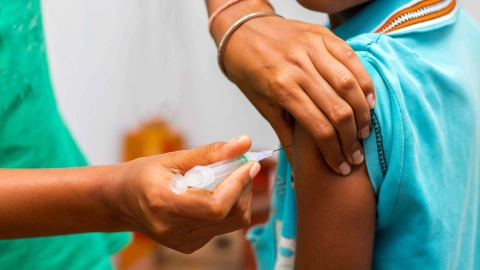Conditions Tetanus
ICD codes: A35 A34 A33 What are ICD codes?
Tetanus (lockjaw) is an infectious disease caused by the toxin from certain bacteria. It can be fatal. Thanks to vaccinations, tetanus is now rare in Germany.
At a glance
- Tetanus is caused by bacteria that are naturally found in the soil all over the world.
- Tetanus is contracted by bacteria getting into the skin via an injury.
- Typical symptoms include muscle spasms, especially in the face and back.
- Despite intensive medical care, tetanus is still fatal for 10 to 20 percent of those affected. If good medical care is not available, the mortality rate is far higher.
- People can protect themselves from the disease with preventive vaccination. Tetanus has become very rare in Germany.
Note: The information in this article cannot and should not replace a medical consultation and must not be used for self-diagnosis or treatment.

What is tetanus?
Tetanus is also known as “lockjaw” because different muscle groups tense up and become stiff.
The infectious disease is triggered by the toxins in tetanus bacteria. If the bacteria get into a wound, an infection and illness can occur.
Vaccination offers protection against tetanus. This is why the disease has become very rare in Germany.
Tetanus has a very high mortality rate, but it decreases to 10 to 20 percent with good intensive care.
Types of tetanus
Doctors differentiate between three types of tetanus:
- Generalized tetanus: this affects the entire body.
- Localized tetanus: this only affects the area around the infected wound.
- Neonatal tetanus: this can affect newborn babies if the mother is insufficiently protected against tetanus.
Important: Localized tetanus is very rare. No cases of neonatal tetanus have been recorded in Germany for decades.
What are the symptoms of tetanus?
Symptoms generally occur 3 days to 3 weeks after infection with the tetanus pathogen (incubation period).
Typical symptoms are:
- sweating, fluctuations in blood pressure and a rapid heartbeat
- painful muscle spasms
- the appearance of a grin caused by tension in the facial muscles
- difficulties opening the mouth due to the masticatory muscles cramping (lockjaw)
- hyperflexion of the back and neck muscles
- stiff neck
- difficulty swallowing
- respiratory problems
Symptoms in newborns
Tetanus can usually be detected in newborns through their inability to properly open their mouth and therefore to drink. It also manifests itself in the form of increased muscle tension and spasms.
How do people get tetanus?
A tetanus infection is always preceded by injury to the skin, for example by a splinter, a nail or an animal bite. This enables the pathogens to get under the skin, where they can multiply.
Tetanus cannot be transmitted person to person.
Which pathogens cause tetanus?
The tetanus pathogen is the bacterium Colstridium tetani. These bacteria are found practically everywhere, especially in soil and in horse manure.
Tetanus bacteria can form spores, a particularly resistant form. Bacterial spores are resistant to environmental influences such as heat or disinfectant. This enables them to survive in the ground for years.
If the living conditions for the bacteria get better again, they change back into forms that can multiply. They multiply particularly well at body temperature and without oxygen.
Tetanus bacteria form toxins that make people ill. If the bacteria have infected a wound and multiplied in it, they produce toxins. These migrate along the nerves to the spinal cord, where usually inhibitory nerves reduce muscle excitation.
But the toxins switch off this inhibition so that the muscles are over-activated, resulting in the muscles tensing up at even the slightest stimulus and the typical tetanus symptoms arising.
Which factors increase the risk of tetanus?
Patients with deep wounds are at particularly high risk of tetanus as the pathogens only multiply under low oxygen conditions.
People who inject drugs or have the following medical conditions are also at particularly high risk:
- Circulatory disorders
- Diabetes mellitus
- Chronic skin conditions
- Dental infections
Important: people who are poorly vaccinated or not vaccinated at all are at the highest risk of getting tetanus.
How common is tetanus?
Tetanus bacteria are found in the soil all over the world. As a result, the pathogens cannot be eradicated and there is a certain risk of infection worldwide.
Tetanus in Germany
There have only been a few cases of tetanus in Germany in recent years. These have primarily involved elderly persons.
There have not been any instances of tetanus in newborns in Germany for decades. The low infection figures are primarily due to vaccination.
Tetanus worldwide
Tetanus cases are still particularly common in humid countries with a low vaccination rate and inadequate medical care. The precise figures are unknown.
However, the approximate number of fatalities can be calculated: every year between 48,000 and 80,000 people die from tetanus worldwide. Most global cases of death from tetanus are caused by the newborn form. Around 25,000 babies died from this form of tetanus in 2018 compared to around 800,000 in 1988. Accordingly, far fewer newborns and babies worldwide are now dying from tetanus.
How does tetanus progress?
How tetanus progresses depends on the form. How the disease progresses also depends on how many tetanus toxins get into the bloodstream.
Generalized tetanus
Generalized tetanus does not affect people who have been vaccinated. This form presents the typical symptoms and progresses in several stages. If the spasms are very severe and simultaneously affect flexors and extensors of the spine, spinal fractures can occur.
In the further course of the disease, the toxins of the tetanus bacteria also attack the nerves supplying the respiratory organs and blood vessels. The patients then have difficulty breathing, fluctuations in blood pressure and sweating. Fatalities are often the result of lung and cardiovascular failure. Thanks to modern intensive care, 80 to 90 percent of patients can be healed.
Localized tetanus
The localized form sometimes occurs if people are only partially immune. This can be the case, for example, if they were vaccinated a long time ago. The symptoms are then limited to the muscles in the immediate vicinity of the wound. This form of tetanus is usually harmless but can develop into the generalized form.
Newborn tetanus
The newborn form can occur if a mother is not vaccinated and the infant’s umbilical stump is not kept hygienically clean. In infants, the tetanus pathogens enter the body through the umbilical stump. If an infection occurs when the umbilical cord is cut, newborns exhibit symptoms within the first two weeks of their life. These include muscle stiffness, spasms and sucking weakness.
How can tetanus be prevented?
People can protect themselves from tetanus by getting vaccinated. The Standing Committee on Vaccination in Germany (Ständige Impfkommission STIKO) recommends different measures for different groups of people.
Vaccine recommendations for infants and children
Infants should receive three vaccine doses for primary immunization: at 2, 4 and 11 months of age. Vaccination usually occurs together with other important vaccinations: against diphtheria, whooping cough, polio, haemophilus influenzae type b (Hib) and hepatitis B.
The first booster for vaccinated children is administered at age 5 to 6 and the second at the age 9 to 16.
Vaccine recommendations for adults
Non-vaccinated adults can catch up on their primary immunization according to the regimen used for children. Vaccinated adults should have a booster every ten years.
Adults usually receive a combination vaccine that also protects against diphtheria or against both diphtheria and whooping cough.
The Robert Koch Institute website provides answers to frequently asked questions about the tetanus vaccination.
The latest STIKO recommendations, a vaccination calendar in 21 languages and the STIKO recommendations in pocket format can also be found on the Robert Koch Institute website.
Video How do vaccinations work?
The video below explains how a vaccination works.
This and other videos can also be found on YouTube
Watch nowThe privacy policy indicated there applies.
How is tetanus diagnosed?
Doctors can reach a definite diagnosis of tetanus on the basis of typical symptoms such as lockjaw and spasms of the muscles in the face and back. An electronic examination of the muscles (electromyography) will also detect increased muscle activity.
To confirm the diagnosis, the existence of the toxins formed by the pathogens can be proven using animal testing. However, this is only necessary and permitted on exceptions.
How is tetanus treated?
Doctors treat tetanus at different levels. On the one hand, they fight the pathogens and their toxins, on the other hand they administer medication to alleviate the symptoms.
Active and passive immunization
If there is an injury, patients who are not vaccinated or whose vaccination status is not known, receive injections of tetanus immunoglobulins. These are antibodies that should render the tetanus toxins harmless (passive immunization).
At the same time, the normal vaccine is given to additionally encourage the body to produce its own antibodies (active immunization).
Patients who are fully vaccinated and whose last vaccination is not too long ago get neither immunoglobulins nor additional vaccination.
Wound care
In the event of deep or contaminated wounds and major tissue damage, a surgeon must carefully clean the wound area and remove any damaged tissue. This prevents the pathogens from multiplying and toxins being produced.
Antibiotics
Although antibiotics cannot fight the pathogenic toxins, they can prevent toxin-producing bacteria from multiplying further. Patients are therefore administered an antibiotic such as metronidazole.
Intensive care
If symptoms of tetanus are already apparent, doctors monitor vital functions such as breathing and circulation in an intensive care unit. In order to avoid spasms, people with tetanus are placed in an environment with as little irritation as possible and given muscle-relaxing medication.
- Arbeitsgemeinschaft der Wissenschaftlichen Medizinischen Fachgesellschaften e.V. (AWMF) und Deutsche Gesellschaft für Neurologie. Leitlinie für Diagnostik und Therapie in der Neurologie: Tetanus. S1-Leitlinie. AWMF- Registernummer 030–104. 03.2024.
Robert Koch-Institut (RKI). Epidemiologisches Bulletin 04/2022. 01.2022.
Robert Koch-Institut (RKI). RKI-Ratgeber: Tetanus. Aufgerufen am 24.11.2022.
Robert Koch-Institut (RKI). Schutzimpfung gegen Tetanus: Häufig gestellte Fragen und Antworten. Aufgerufen am 25.11.2022.
UpToDate (Internet). Tetanus. Wolters Kluwer 2022. 24.11.2022
World Health Organization (WHO). Health Topics: Tetanus. Aufgerufen am 24.11.2022.
Reviewed by the German Brain Foundation (Deutsche Hirnstiftung e.V. – DHS)
As at:





